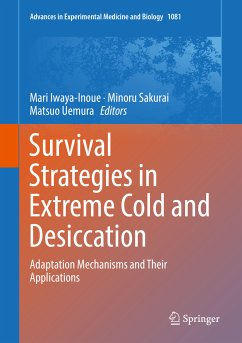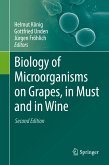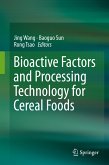Survival Strategies in Extreme Cold and Desiccation (eBook, PDF)
Adaptation Mechanisms and Their Applications
Redaktion: Iwaya-Inoue, Mari; Uemura, Matsuo; Sakurai, Minoru
160,95 €
160,95 €
inkl. MwSt.
Sofort per Download lieferbar

80 °P sammeln
160,95 €
Als Download kaufen

160,95 €
inkl. MwSt.
Sofort per Download lieferbar

80 °P sammeln
Jetzt verschenken
Alle Infos zum eBook verschenken
160,95 €
inkl. MwSt.
Sofort per Download lieferbar
Alle Infos zum eBook verschenken

80 °P sammeln
Survival Strategies in Extreme Cold and Desiccation (eBook, PDF)
Adaptation Mechanisms and Their Applications
Redaktion: Iwaya-Inoue, Mari; Uemura, Matsuo; Sakurai, Minoru
- Format: PDF
- Merkliste
- Auf die Merkliste
- Bewerten Bewerten
- Teilen
- Produkt teilen
- Produkterinnerung
- Produkterinnerung

Bitte loggen Sie sich zunächst in Ihr Kundenkonto ein oder registrieren Sie sich bei
bücher.de, um das eBook-Abo tolino select nutzen zu können.
Hier können Sie sich einloggen
Hier können Sie sich einloggen
Sie sind bereits eingeloggt. Klicken Sie auf 2. tolino select Abo, um fortzufahren.

Bitte loggen Sie sich zunächst in Ihr Kundenkonto ein oder registrieren Sie sich bei bücher.de, um das eBook-Abo tolino select nutzen zu können.
Introduces basic biological phenomena associated with survival of plants, microorganisms and animals under severe environmental stress conditions Provides information of unique and characteristic mechanisms and biomaterials to contribute to the survival Describes new technologies of drugs, cells, tissues and organs to enhance the quality of our life and/or prolong lifetime
- Geräte: PC
- ohne Kopierschutz
- eBook Hilfe
- Größe: 15.43MB
Andere Kunden interessierten sich auch für
![Biology of Microorganisms on Grapes, in Must and in Wine (eBook, PDF) Biology of Microorganisms on Grapes, in Must and in Wine (eBook, PDF)]() Biology of Microorganisms on Grapes, in Must and in Wine (eBook, PDF)216,95 €
Biology of Microorganisms on Grapes, in Must and in Wine (eBook, PDF)216,95 €![Natural UV Radiation in Enhancing Survival Value and Quality of Plants (eBook, PDF) Natural UV Radiation in Enhancing Survival Value and Quality of Plants (eBook, PDF)]() Swati Sen MandiNatural UV Radiation in Enhancing Survival Value and Quality of Plants (eBook, PDF)112,95 €
Swati Sen MandiNatural UV Radiation in Enhancing Survival Value and Quality of Plants (eBook, PDF)112,95 €![Bioactive Factors and Processing Technology for Cereal Foods (eBook, PDF) Bioactive Factors and Processing Technology for Cereal Foods (eBook, PDF)]() Bioactive Factors and Processing Technology for Cereal Foods (eBook, PDF)72,95 €
Bioactive Factors and Processing Technology for Cereal Foods (eBook, PDF)72,95 €![Romeis - Mikroskopische Technik (eBook, PDF) Romeis - Mikroskopische Technik (eBook, PDF)]() Romeis - Mikroskopische Technik (eBook, PDF)86,99 €
Romeis - Mikroskopische Technik (eBook, PDF)86,99 €![Cell Biology and Translational Medicine, Volume 27 (eBook, PDF) Cell Biology and Translational Medicine, Volume 27 (eBook, PDF)]() Cell Biology and Translational Medicine, Volume 27 (eBook, PDF)128,95 €
Cell Biology and Translational Medicine, Volume 27 (eBook, PDF)128,95 €![Microbial Control and Food Preservation (eBook, PDF) Microbial Control and Food Preservation (eBook, PDF)]() Microbial Control and Food Preservation (eBook, PDF)120,95 €
Microbial Control and Food Preservation (eBook, PDF)120,95 €![Cyanidioschyzon merolae (eBook, PDF) Cyanidioschyzon merolae (eBook, PDF)]() Cyanidioschyzon merolae (eBook, PDF)160,95 €
Cyanidioschyzon merolae (eBook, PDF)160,95 €-
-
-
Introduces basic biological phenomena associated with survival of plants, microorganisms and animals under severe environmental stress conditions Provides information of unique and characteristic mechanisms and biomaterials to contribute to the survival Describes new technologies of drugs, cells, tissues and organs to enhance the quality of our life and/or prolong lifetime
Dieser Download kann aus rechtlichen Gründen nur mit Rechnungsadresse in A, B, BG, CY, CZ, D, DK, EW, E, FIN, F, GR, HR, H, IRL, I, LT, L, LR, M, NL, PL, P, R, S, SLO, SK ausgeliefert werden.
Produktdetails
- Produktdetails
- Verlag: Springer Nature Singapore
- Seitenzahl: 409
- Erscheinungstermin: 4. Oktober 2018
- Englisch
- ISBN-13: 9789811312441
- Artikelnr.: 54228603
- Verlag: Springer Nature Singapore
- Seitenzahl: 409
- Erscheinungstermin: 4. Oktober 2018
- Englisch
- ISBN-13: 9789811312441
- Artikelnr.: 54228603
- Herstellerkennzeichnung Die Herstellerinformationen sind derzeit nicht verfügbar.
Mari Iwaya-Inoue is currently a professor emerita of Kyushu University, Fukuoka, Japan, since 2017 and is also the auditor of the Japan International Research Center for Agricultural Sciences (JIRCAS), Tsukuba, since 2015. Dr. Iwaya-Inoue has been a professor, Faculty of Agriculture, Kyushu University (2004-2017) and also was appointed as vice dean of the Faculty of Agriculture (2013-2015) and vice president (Student Affairs, Promotion of Gender Equality) of Kyushu University (2014-2017). She is a regular contributor to the Japanese Society of Cryobiology and Cryotechnology and the Japanese Society of Crop Science, and she has been a member of the Japanese Society of Plant Physiologists and the Botanical Society of Japan, among others. Her research interest is plant-water relations, especially the effects of environmental stresses on physical states of water and nutrient accumulation mechanisms in crop seeds. Minoru Sakurai has been a professor at Tokyo Institute of Technology (Center for Biological Resources and Informatics) since 2003. Dr. Sakurai is a regular contributor to the Japanese Society of Cryobiology and Cryotechnology and is a member of the Biophysical Society of Japan, the Protein Science Society of Japan, the Chemical Society of Japan, and the American Chemical Society. His current research interests are experimental and theoretical elucidation of the mechanism of anhydrobiosis (life without water), and atomic-level elucidation of the functional mechanisms of ABC transporters based on first-principles computer simulations. Matsuo Uemura is currently a professor in the Department of Plant-Biosciences, Iwate University (Morioka, Japan). Dr. Uemura has been a vice president (International Liaison and Public Relations) of Iwate University since 2014 as well as visiting professor in the Department of Plant Sciences at the University of Saskatchewan (Saskatoon, Canada) since 2012. He is a member of the Japanese Society of Cryobiology and Cryotechnology, the Society for Cryobiology, the Japanese Society of Plant Physiologists, the Botanical Society of Japan, and the American Society of Plant Biologists, among other organizations. His research interests include membrane participation in plant cold acclimation and freezing injury and the molecular and physiological aspects of adaptation processes to low temperatures in plants.
Part 1. Adaptation Mechanisms for Cold.Gene Regulatory Networks Mediating Cold Acclimation: the CBF Pathway.- RNA Regulation in Plant Cold Stress Response.- The Mechanism Enabling Hibernation in Mammals.- Freezing Tolerance of Plant Cells: from the Aspect of Plasma Membrane and Microdomain.- Natural Variation in Freezing Tolerance and Cold AcclimationResponse in Arabidopsis thaliana and Related Species.- Ice nucleation activity in plants: the distribution, characterization and their roles in cold hardiness mechanisms.- Investigating Freezing Patterns in Plants Using Infrared Thermography.- Mechanism of Overwintering in Trees.- The Mechanism of Low-temperature Tolerance in Fish. Part 2. Adaptation Mechanisms for Desiccation. Mechanisms Underlying Freezing and Desiccation Tolerance in Bryophytes.- Regulatory Gene Networks in Drought Stress Responses and Resistance in Plants.- Mechanism of Stomatal Closure in Plants Exposed to Drought and Cold Stress.- Mechanismsof Maturation and Germination in Crop Seeds Exposed to Environmental Stresses with a Focus on Nutrients, Water Status, and Reactive Oxygen Species.- The Antioxidant System in the Anhydrobiotic Midge as an Essential, Adaptive Mechanism for Desiccation Survival.- Physicochemical Aspects of The Biological Functions of Trehalose and Group 3 LEA Proteins as Desiccation Protectants.- Part 3. Application Technologies from Laboratory to Society. Supercooling-Promoting (Anti-Ice Nucleation) Substances.- Applications of Antifreeze Proteins: Practical Use of the Quality Products from Japanese Fishes.- Development and Application of Cryoprotectants.- Cryopreservation of Plant Genetic Resources.- Application of protein and cell stabilization for pharmaceuticals.- Control of Physical Changes in Food Products.
Part 1. Adaptation Mechanisms for Cold.Gene Regulatory Networks Mediating Cold Acclimation: the CBF Pathway.- RNA Regulation in Plant Cold Stress Response.- The Mechanism Enabling Hibernation in Mammals.- Freezing Tolerance of Plant Cells: from the Aspect of Plasma Membrane and Microdomain.- Natural Variation in Freezing Tolerance and Cold AcclimationResponse in Arabidopsis thaliana and Related Species.- Ice nucleation activity in plants: the distribution, characterization and their roles in cold hardiness mechanisms.- Investigating Freezing Patterns in Plants Using Infrared Thermography.- Mechanism of Overwintering in Trees.- The Mechanism of Low-temperature Tolerance in Fish. Part 2. Adaptation Mechanisms for Desiccation. Mechanisms Underlying Freezing and Desiccation Tolerance in Bryophytes.- Regulatory Gene Networks in Drought Stress Responses and Resistance in Plants.- Mechanism of Stomatal Closure in Plants Exposed to Drought and Cold Stress.- Mechanismsof Maturation and Germination in Crop Seeds Exposed to Environmental Stresses with a Focus on Nutrients, Water Status, and Reactive Oxygen Species.- The Antioxidant System in the Anhydrobiotic Midge as an Essential, Adaptive Mechanism for Desiccation Survival.- Physicochemical Aspects of The Biological Functions of Trehalose and Group 3 LEA Proteins as Desiccation Protectants.- Part 3. Application Technologies from Laboratory to Society. Supercooling-Promoting (Anti-Ice Nucleation) Substances.- Applications of Antifreeze Proteins: Practical Use of the Quality Products from Japanese Fishes.- Development and Application of Cryoprotectants.- Cryopreservation of Plant Genetic Resources.- Application of protein and cell stabilization for pharmaceuticals.- Control of Physical Changes in Food Products.







